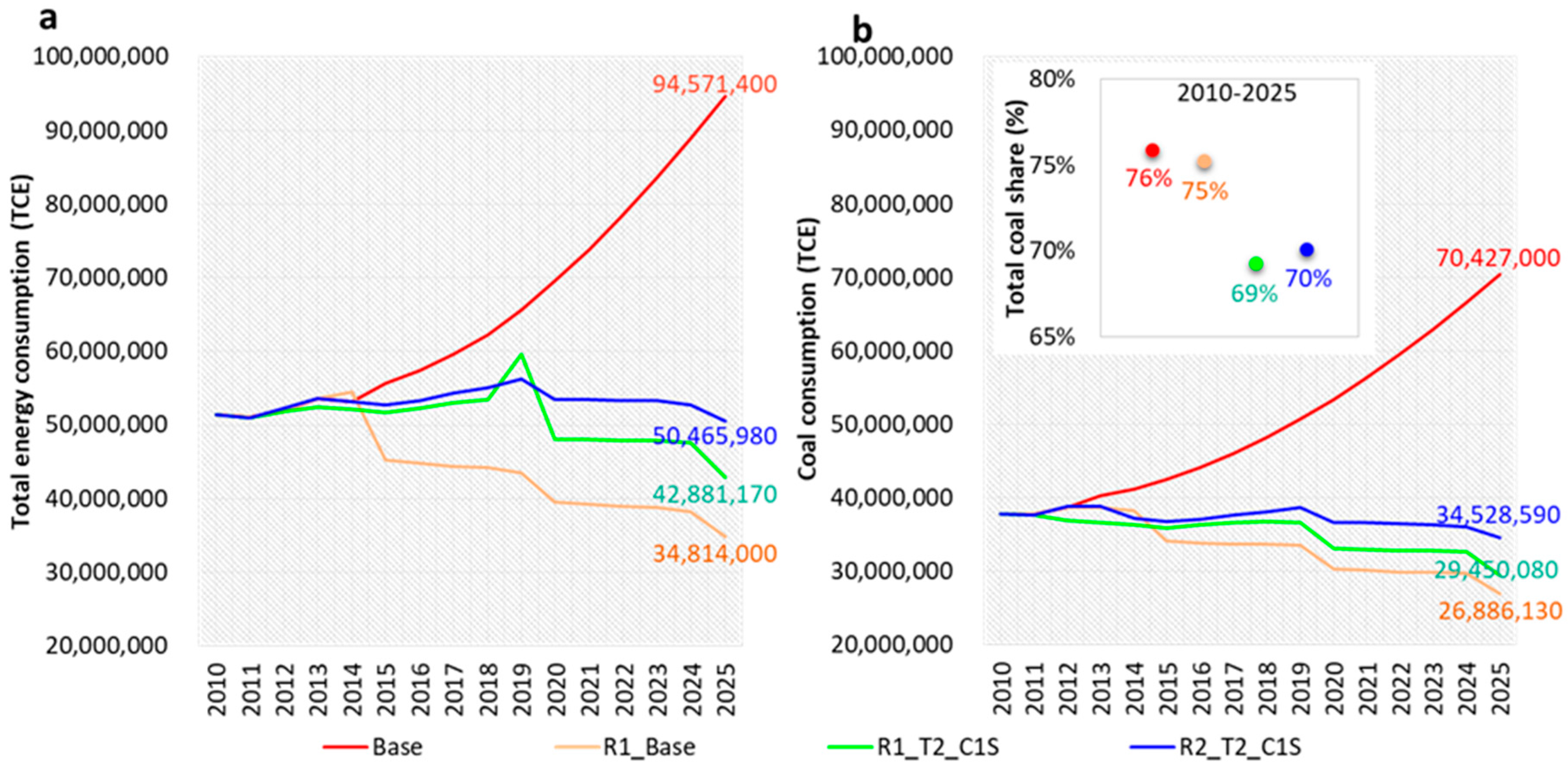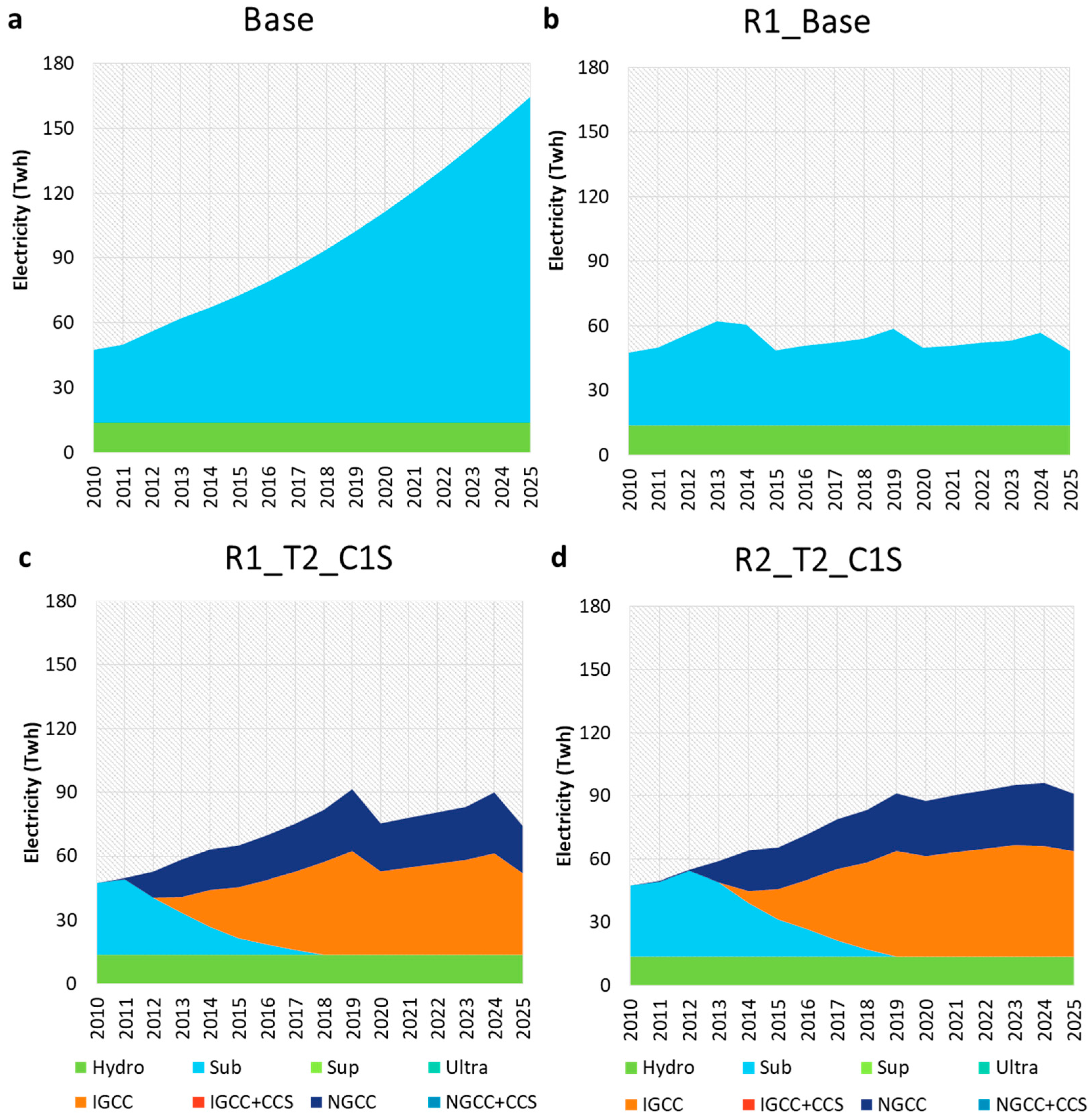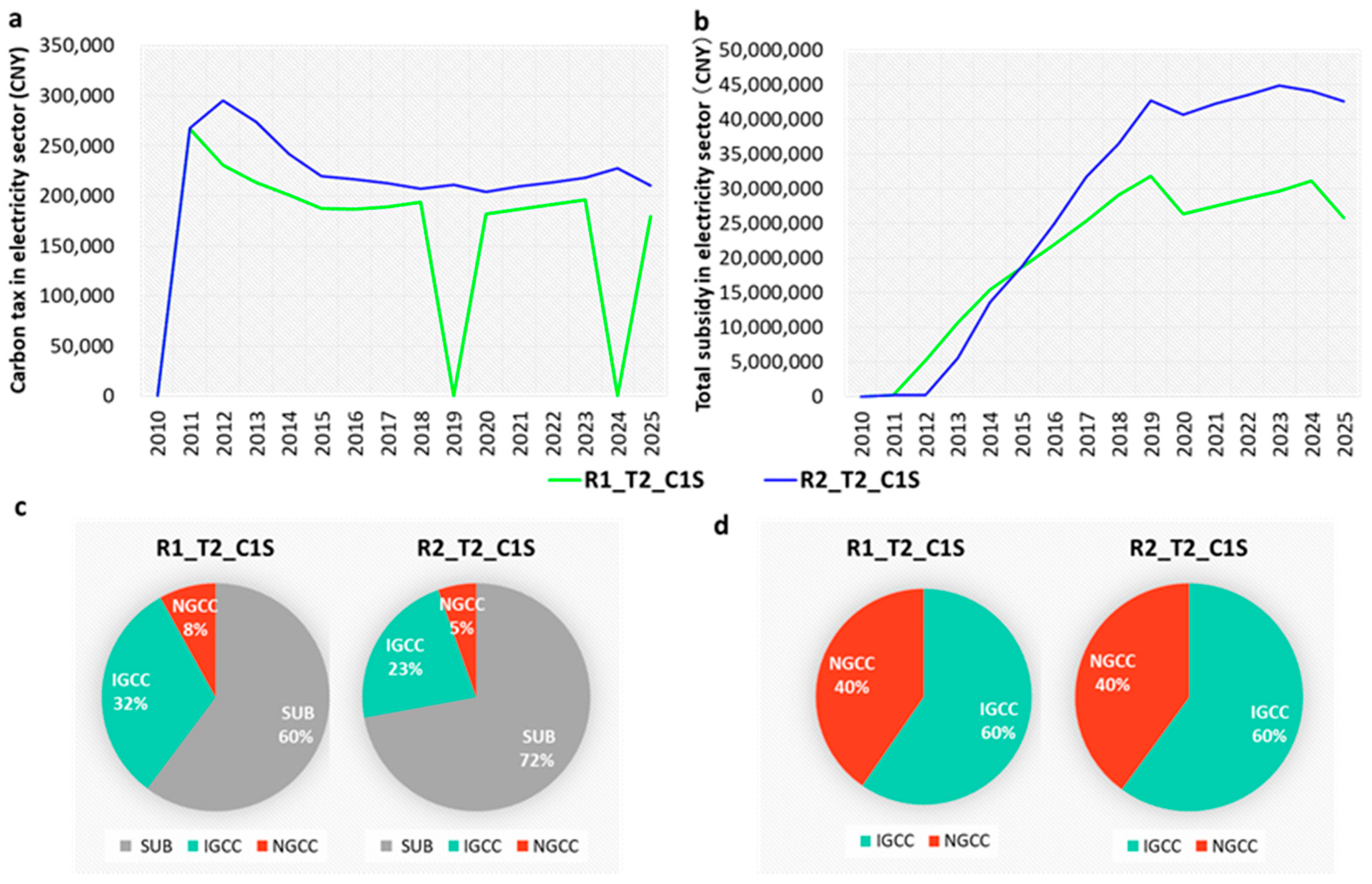Evaluation of Integrated Air Pollution and Climate Change Policies: Case Study in the Thermal Power Sector in Chongqing City, China
Abstract
1. Introduction
2. Climate Change and Pollution Mitigation Challenges
3. Materials and Methods
3.1. Dynamic I-O Model
3.1.1. Economic Indicator GRP
3.1.2. Energy Consumption
3.1.3. Model Dynamics
3.1.4. Air Pollution and GHG Emissions
3.1.5. Regional Government Environmental Regulation Constraints
3.1.6. Technology Innovation and Its Cost Reduction
3.1.7. Carbon Taxes and Subsidies
3.2. Data Setting
3.3. Scenario Design
4. Results and Discussion
4.1. Impact Analysis of Proposed Policies on Economy and Environment
4.2. Impact on Energy Consumption
4.3. Impact on Technology Innovation in the Thermal Power Sector
4.4. Optimal Carbon Taxes and Subsidies for Technology Innovation
5. Conclusions
Acknowledgments
Author Contributions
Conflicts of Interest
Appendix A
| i | Industry | Sector |
|---|---|---|
| 1 | Usual Goods and Services | Agriculture, Forestry, Animal Husbandry and Fishery |
| Transport and Postal Services | ||
| Waste Treatment | ||
| Other Industries | ||
| e | Conventional Energy Industries | Hydropower and Subcritical (SUB) Technology Power Supply |
| Production and Supply of Gas | ||
| 2 | Energy-Intensive Industries | Mining and Washing of Coal |
| Manufacture of Raw Chemical Materials and Products | ||
| Manufacture of Non-Metallic Mineral Products | ||
| Smelting and Pressing of Ferrous Metals | ||
| 3 | Advanced Technology Options (High-Efficiency, Low-Emission Coal–Natural Gas-Fired Power Generation) | Natural Gas Combined Cycle (NGCC) |
| NGCC and Carbon Capture and Storage (NGCC-CCS) | ||
| IGCC-CCS Technology Power Supply | ||
| Integrated Coal Gasification Combined Cycle (IGCC) | ||
| Ultra-Supercritical (USC) Technology Power Supply | ||
| Supercritical (SC) Technology Power Supply |
| Capital Costs ($2010 per kW) | O & M Costs ($2010 per kW) | Efficiency (Gross, LHV) | |||||||
|---|---|---|---|---|---|---|---|---|---|
| 2010 | 2020 | 2035 | 2010 | 2020 | 2035 | 2010 | 2020 | 2035 | |
| Steam Coal-SUB | 600 | 600 | 600 | 21 | 21 | 21 | 37% | 37% | 37% |
| Steam Coal-SUP | 700 | 700 | 700 | 28 | 28 | 28 | 42% | 42% | 42% |
| Steam Coal-USC | 800 | 800 | 800 | 32 | 32 | 32 | 46% | 48% | 50% |
| IGCC | 1100 | 1100 | 900 | 50 | 50 | 41 | 47% | 49% | 51% |
| IGCC-CCS | 1800 | 1800 | 1600 | 81 | 81 | 72 | 38% | 40% | 44% |
| NGCC | 550 | 550 | 550 | 18 | 18 | 18 | 57% | 59% | 61% |
| NGCC-CCS | 1000 | 1000 | 1000 | 33 | 33 | 33 | 49% | 51% | 54% |
References
- United Nations Statistics Division. Environmental Indicators: Greenhouse Gas Emissions, 2010. Available online: http://unstats.un.org/unsd/environment/air_co2_emissions.htm (accessed on 15 July 2017).
- Environmental Health & Engineering. Emissions of Hazardous Air Pollutants from Coal-Fired Power Plants; EH & E Report 17505; Environmental Health & Engineering: Needham, MA, USA, 2011. [Google Scholar]
- Liu, X.; Wen, Z. Best available techniques and pollution control: A case study on China’s thermal power industry. J. Clean. Prod. 2012, 23, 113–121. [Google Scholar] [CrossRef]
- US Energy Information Administration. China Analysis Briefs; USEIA: Washington, DC, USA, 2014. Available online: http://www.eia.gov/countries/analysisbriefs/China/china.pdf (accessed on 10 January 2017).
- Organization for Economic Co-Operation and Development; International Energy Agency. World Energy Outlook 2012; OECD: Paris, France; IEA: Paris, France, 2012. [Google Scholar]
- Organization for Economic Co-operation and Development. OECD Environmental Performance Reviews: China; OECD: Paris, France, 2007. [Google Scholar]
- Leggett, J.A. China’s Greenhouse Gas Emissions and Mitigation Policies; Report for Congress; Congressional Research Service: Washington, DC, USA, 2011. [Google Scholar]
- Lu, Z.; Zhang, Q.; Streets, D.G. Sulfur dioxide and primary carbonaceous aerosol emissions in China and India, 1996–2010. Atmos. Chem. Phys. 2011, 11, 9839–9864. [Google Scholar] [CrossRef]
- Zhao, B.; Wang, S.; Wang, J.; Fu, J.; Liu, T.; Xu, J.; Fu, X.; Hao, J. Impact of national NOx and SO2 control Policies on particulate matter pollution in China. Atmos. Environ. 2013, 77, 453–463. [Google Scholar] [CrossRef]
- Khanna, N.; Fridley, D.; Zhou, N.; Ke, J. Implications of Maximizing China’s Technical Potential for Residential End-Use Energy Efficiency: A 2030 Outlook from the Bottom-Up; China Energy Group, Environmental Energy Technologies Division, Lawrence Berkeley National Laboratory: Berkeley, CA, USA, 2013. [Google Scholar]
- US Energy Information Administration. International Energy Statistics; USEIA: Washington, DC, USA, 2015. Available online: http://www.eia.gov/cfapps/ipdbproject/IEDIndex3.cfm (accessed on 15 July 2017).
- Wang, S.; Hao, J. Air quality management in China: Issues, challenges, and options. J. Environ. Sci. 2012, 24, 2–13. [Google Scholar] [CrossRef]
- Popp, D. International innovation and diffusion of air pollution control technologies: The effects of NOX and SO2 regulation in the US, Japan, and Germany. J. Environ. Econ. Manag. 2006, 51, 46–71. [Google Scholar] [CrossRef]
- Yabar, H.; Uwasu, M.; Hara, K. Tracking environmental innovations and policy regulations in Japan: Case studies on dioxin emissions and electric home appliances recycling. J. Clean. Prod. 2013, 44, 152–158. [Google Scholar] [CrossRef]
- Balash, P.; Nichols, C.; Victor, N. Multi-regional evaluation of the US electricity sector under technology and policy uncertainties: Findings from MARKAL EPA9rUS modeling. Socio-Econ. Plan. Sci. 2013, 47, 89–119. [Google Scholar] [CrossRef]
- Mondal, M.A.H.; Mathur, J.; Denich, M. Impacts of CO2 emission constraints on technology selection and energy resources for power generation in Bangladesh. Energy Policy 2011, 39, 2043–2050. [Google Scholar] [CrossRef]
- Zhang, S.; Worrel, E.; Crijns-Graus, W.; Wagner, F.; Cofala, J. Co-benefits of energy efficiency improvement and air pollution abatement in the Chinese iron and steel industry. Energy 2014, 78, 333–345. [Google Scholar] [CrossRef]
- Cai, W.; Wang, C.; Wang, K.; Zhang, Y.; Chen, J. Scenario analysis on CO2 emissions reduction potential in China’s electricity sector. Energy Policy 2007, 35, 6445–6456. [Google Scholar] [CrossRef]
- Zhang, Q.; Tian, W.; Wei, Y.; Chen, Y. External costs from electricity generation of China up to 2030 in energy and abatement scenarios. Energy Policy 2007, 35, 4295–4304. [Google Scholar] [CrossRef]
- Yu, F.; Chen, J.; Sun, F.; Zeng, S.; Wang, C. Trend of technology innovation in China’s coal-fired electricity industry under resource and environmental constraints. Energy Policy 2011, 39, 1586–1599. [Google Scholar] [CrossRef]
- Tan, Q.; Wen, Z.; Chen, J. Goal and technology path of CO2 mitigation in China’s cement industry: From the perspective of co-benefit. J. Clean. Prod. 2016, 114, 299–313. [Google Scholar] [CrossRef]
- Li, X.; Qiao, Y.; Shi, L. The aggregate effect of air pollution regulation on CO2 mitigation in China’s manufacturing industry: An econometric analysis. J. Clean. Prod. 2017, 142, 976–984. [Google Scholar] [CrossRef]
- Zheng, J.; Jiang, P.; Qiao, W.; Zhu, Y.; Kennedy, E. Analysis of air pollution reduction and climate change mitigation in the industry sector of Yangtze River Delta in China. J. Clean. Prod. 2016, 114, 314–322. [Google Scholar] [CrossRef]
- Liu, Z.; Mao, X.; Tu, J.; Jaccard, M. A comparative assessment of economic-incentive and command-and-control instruments for air pollution and CO2 control in China’s iron and steel sector. J. Environ. Manag. 2014, 144, 135–142. [Google Scholar] [CrossRef] [PubMed]
- Zhou, Q.; Yabar, H.; Mizunoya, T.; Higano, Y. Exploring the potential of introducing technology innovation and regulations in the energy sector in China: A regional dynamic evaluation model. J. Clean. Prod. 2016, 112, 1537–1548. [Google Scholar] [CrossRef]
- Cansino, J.M.; Cardenete, M.A.; González-Limón, J.M.; Román, R. The economic influence of photovoltaic technology on electricity generation: A CGE (computable general equilibrium) approach for the Andalusian case. Energy 2014, 73, 70–79. [Google Scholar] [CrossRef]
- Nielsen, C.P.; Ho, M.S. Clearer Skies over China: Reconciling Air Pollution, Climate, and Economic Goals; MIT Press: Cambridge, MA, USA, 2013. [Google Scholar]
- Jiang, P.; Chen, Y.; Geng, Y.; Dong, W.; Xue, B.; Xu, B.; Li, W. Analysis of the co-benefits of climate change mitigation and air pollution reduction in China. J. Clean. Prod. 2013, 58, 130–137. [Google Scholar] [CrossRef]
- Nam, K.M.; Waugh, C.J.; Paltsev, S.; Reilly, J.M.; Karplus, V.J. Synergy between pollution and carbon emissions control: Comparing China and the United States. Energy Econ. 2014, 46, 186–201. [Google Scholar] [CrossRef]
- China Council for International Cooperation on Environment and Development. Sustainable Use of Coal and Pollution Control Policy in China; CCICED Policy Research Report; China Council for International Cooperation on Environment and Development: Beijing, China, 2009. [Google Scholar]
- Arrow, K.J.; Cline, W.R.; Maler, K.G.; Munasinghe, M.; Squitieri, R.; Stiglitz, J.E. Intertemporal Equity, Discounting, and Economic Efficiency. In Climate Change 1995: Economic and Social Dimensions—Contribution of Working Group III to the Second Assessment Report of the Intergovernmental Panel on Climate Change; Bruce, J.P., Lee, H., Haites, E.F., Eds.; Cambridge University Press: Cambridge, MA, USA, 1996; pp. 125–144. [Google Scholar]
- Nordhaus, W.D. A Review of the Stern Review on the Economics of Climate Change. J. Econ. Lit. 2007, 45, 686–702. [Google Scholar] [CrossRef]
- Cline, W.R. The Economics of Global Warming; Institute for International Economics: Washington, DC, USA, 1992. [Google Scholar]
- Bureau of Statistics of Chongqing. Chongqing Statistical Yearbook; Bureau of Statistics of Chongqing: Chongqing, Chana; Chinese Statistical Publishing House: Beijing, China, 2011.
- Intergovernmental Panel on Climate Change (IPCC). 2006 IPCC Guidelines for National Greenhouse Gas Inventories; Institute for Global Environmental Strategies: Hayama, Japan, 2006. [Google Scholar]
- Liu, F.; Klimont, Z.; Zhang, Q.; Cofala, J.; Zhao, L.; Huo, H.; Nguyen, B.; Schöpp, W.; Sander, R.; Zheng, B.; et al. Integrating mitigation of air pollutants and greenhouse gases in Chinese cities: Development of GAINS-City model for Beijing. J. Clean. Prod. 2013, 58, 25–33. [Google Scholar] [CrossRef]
- Platts. UDI World Electric Power Plants Data Base, 2012. Available online: http://www.powerdat.platts.com/IM.Platts.Content/downloads/udi/wepp/weppreg.pdf (accessed on 27 September 2017).
- IEA. World Energy Outlook; International Energy Agency: Paris, France, 2011; Available online: http://www.worldenergyoutlook.org/media/weowebsite/energymodel/WEO_2011_PG_Assumptions_450_Scenario.xls (accessed on 15 July 2017).
- International Energy Agency. Technology Roadmap: High-Efficiency, Low-Emissions Coal-Fired Power Generation; International Energy Agency: Paris, France, 2012. [Google Scholar]
- Higano, Y.; Mizunoya, T.; Kobayashi, S.; Taguchi, K.; Sakurai, K. A study on synthetic regional environmental policies for utilising biomass resources. Int. J. Environ. Technol. Manag. 2009, 11, 102–117. [Google Scholar] [CrossRef]
- Li, Y.; Zou, S.; Xu, F.; Yabar, H.; Higano, Y. The impact of introducing recycling taxes on China’s environmental policy: Case study on E-waste recycling. J. Sustain. Dev. 2012, 5, 83–98. [Google Scholar] [CrossRef]
- Lu, K.; Nozaki, N.; Mizunoya, T.; Yabar, H.; Higano, Y. Analysis of the Environmental and Socio-economic Benefits of Introducing Cleaner Vehicles in China: Policy Implications. J. Sustain. Dev. 2015, 8, 297–309. [Google Scholar] [CrossRef]
- Shen, Z.; Mizunoya, T.; Higano, Y. Agriculture and sustainable development: Policies analysis of the Taihu Economic Circle in China. Int. J. Foresight Innov. Policy 2012, 8, 210–235. [Google Scholar] [CrossRef]
- Song, J.; Yang, W.; Higano, Y.; Wang, X. Introducing renewable energy and industrial restructuring to reduce GHG emission: Application of a dynamic simulation model. Energy Convers. Manag. 2015, 96, 625–636. [Google Scholar] [CrossRef]
- Wang, S.; Xu, F.; Xiang, N.; Mizunoya, T.; Yabar, H.; Higano, Y.; Zhang, R. A simulation analysis of the introduction of an environmental tax to develop biomass power technology in China. J. Sustain. Dev. 2012, 6, 19–31. [Google Scholar] [CrossRef][Green Version]
- Xiang, N.; Xu, F.; Sha, J. Simulation analysis of China’s energy and industrial structure adjustment potential to achieve a low-carbon economy by 2020. Sustainability 2013, 5, 5081–5099. [Google Scholar] [CrossRef]
- Xu, F.; Xiang, N.; Yan, J.; Chen, L.; Nijkamp, P.; Higano, Y. Dynamic simulation of China’s carbon emission reduction potential by 2020. Lett. Spat. Resour. Sci. 2015, 8, 15–27. [Google Scholar] [CrossRef]
- Yang, W.; Song, J.; Higano, Y.; Tang, J. An Integrated Simulation Model for Dynamically Exploring the Optimal Solution to Mitigating Water Scarcity and Pollution. Sustainability 2015, 7, 1774–1797. [Google Scholar] [CrossRef]
- Zhang, G.F.; Sha, J.H.; Wang, T.Y.; Yan, J.J.; Higano, Y. Comprehensive Evaluation of Socio-Economic and Environmental Impacts Using Membrane Bioreactors for Sewage Treatment in Beijing. J. Pure Appl. Microbiol. 2013, 7, 553–564. [Google Scholar]
- Zou, Y.; Wang, S.; Mizunoya, T.; Yabar, H.; Higano, Y. Research on environmental tax with emphasis on developing renewable energy in Beijing, China. J. Sustain. Dev. 2014, 7, 78–88. [Google Scholar] [CrossRef]
- Jotzo, F.; De Boer, D.; Kater, H. China Carbon Pricing Survey 2013; No. 1305; Centre for Climate, Economics & Policy, Crawford School of Public Policy, The Australian National University: Canberra, Australia, 2013. [Google Scholar]
- Zhou, Q.; Yabar, H.; Mizunoya, T.; Higano, Y.; Yang, W. Comprehensive Analysis of the Environmental Benefits of Introducing Technology Innovation in the Energy Sector: Case Study in Chongqing City, China. J. Sustain. Dev. 2013, 6, 71–83. [Google Scholar] [CrossRef][Green Version]
- CCOALNEWS. Experts Predict Coal Consumption Peak: In 2020, 4.7 Billion Tons. 2014. Available online: http://www.ccoalnews.com/101773/101786/238350.html (accessed on 13 July 2015). (In Chinese).
- Morioka, T.; Saito, O.; Yabar, H. The pathway to a sustainable industrial society—Initiative of the Research Institute for Sustainability Science (RISS) at Osaka University. Sustain. Sci. 2006, 1, 65–82. [Google Scholar] [CrossRef][Green Version]



| Scenarios | Government Regulation | Technology Innovation | Carbon Tax and Subsidy |
|---|---|---|---|
| Base | No | No | no |
| R1_Base | Yes | No | no |
| R1_T1_C1S | Yes (10%) | Yes | 70 CNY/ton tax |
| R1_T1_C2S | Yes (10%) | Yes | 110 CNY/ton tax |
| R1_T2_C1S | Yes (10%) | Cost reduction of 10% | 70 CNY/ton tax |
| R1_T2_C2S | Yes (10%) | Cost reduction of 10% | 110 CNY/ton tax |
| R2_T2_C1S | Yes (5%) | Cost reduction of 10% | 70 CNY/ton tax |
| R2_T2_C2S | Yes (5%) | Cost reduction of 10% | 110 CNY/ton tax |
| R0_T1_C1S | No | Yes | 70 CNY/ton tax |
| R0_T1_C2S | No | Yes | 110 CNY/ton tax |
| R0_T2_C1S | No | Cost reduction of 10% | 70 CNY/ton tax |
| R0_T2_C2S | No | Cost 10% reduction | 110 CNY/ton tax |
| GRP | GHG | SO2 | NOx | PM10 | PM2.5 | ||
|---|---|---|---|---|---|---|---|
| Group 0 | R1_Base | −42.50% | −32.86% | −35.84% | −41.29% | −33.44% | −34.97% |
| Group 1 | R0_T1_C1S | 0.26% | 0.10% | 0.28% | −0.40% | 0.42% | 0.25% |
| R0_T1_C2S | 0.37% | 0.13% | 0.30% | −0.36% | 0.46% | 0.28% | |
| R0_T2_C1S | 0.26% | 0.10% | 0.28% | −0.40% | 0.42% | 0.25% | |
| R0_T2_C2S | 0.37% | 0.13% | 0.30% | −0.36% | 0.46% | 0.28% | |
| Group 2 | R1_T1_C1S | −22.64% | −30.76% | −37.88% | −41.13% | −30.68% | −34.74% |
| R1_T1_C2S | −22.54% | −30.76% | −37.88% | −41.14% | −30.66% | −34.73% | |
| R1_T2_C1S | −22.56% | −30.74% | −37.87% | −41.12% | −30.66% | −34.73% | |
| R1_T2_C2S | −22.61% | −30.77% | −37.89% | −41.15% | −30.68% | −34.75% | |
| Group 3 | R2_T2_C1S | −15.79% | −26.62% | −33.64% | −36.42% | −26.17% | −30.41% |
| R2_T2_C2S | −15.83% | −26.61% | −33.63% | −36.42% | −26.15% | −30.40% |
© 2017 by the authors. Licensee MDPI, Basel, Switzerland. This article is an open access article distributed under the terms and conditions of the Creative Commons Attribution (CC BY) license (http://creativecommons.org/licenses/by/4.0/).
Share and Cite
Zhou, Q.; Yabar, H.; Mizunoya, T.; Higano, Y. Evaluation of Integrated Air Pollution and Climate Change Policies: Case Study in the Thermal Power Sector in Chongqing City, China. Sustainability 2017, 9, 1741. https://doi.org/10.3390/su9101741
Zhou Q, Yabar H, Mizunoya T, Higano Y. Evaluation of Integrated Air Pollution and Climate Change Policies: Case Study in the Thermal Power Sector in Chongqing City, China. Sustainability. 2017; 9(10):1741. https://doi.org/10.3390/su9101741
Chicago/Turabian StyleZhou, Qian, Helmut Yabar, Takeshi Mizunoya, and Yoshiro Higano. 2017. "Evaluation of Integrated Air Pollution and Climate Change Policies: Case Study in the Thermal Power Sector in Chongqing City, China" Sustainability 9, no. 10: 1741. https://doi.org/10.3390/su9101741
APA StyleZhou, Q., Yabar, H., Mizunoya, T., & Higano, Y. (2017). Evaluation of Integrated Air Pollution and Climate Change Policies: Case Study in the Thermal Power Sector in Chongqing City, China. Sustainability, 9(10), 1741. https://doi.org/10.3390/su9101741





